Home
Eglfing-Haar (Oberbayrische Kreis-, Heil- und Pflegeanstalt
Eglfing-Haar)
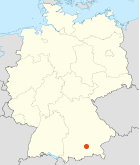
The Kinderfachabteilung in Eglfing-Haar existed between October 1940
(as the first of three in Bavaria and the third one overall) and May
1945. Its medical director was Dr. Hermann Pfannmueller,
and the physicians responsible for the special children's ward were Dr.
Gustav Eidam, Dr. Fritz Kuehnke, and Dr. Ernst
Wentzler. Dr. Pfannmueller was
sentenced in 1951 in Munich to a five-year prison term and died in 1961. Dr.
Eidam committed suicide in 1945. Dr. Kuehnke also
traveled to the Kinderfachabteilung Wiesloch to kill children there (see Wiesloch);
after the war he was a pediatrician in Hamburg, and a state attorney's
investigation against him was stopped in 1969. Dr. Wentzler
operated a private children's clinic in Berlin-Frohnau after the war and
died in 1973.
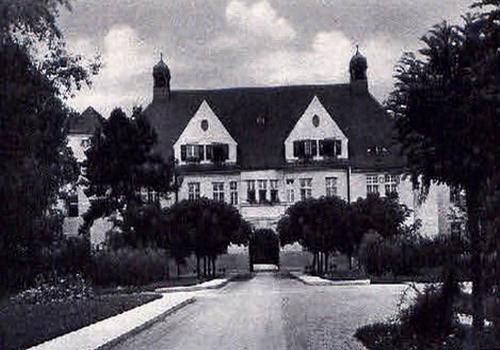 Source: http://www.kaiss.eu/8.html
Source: http://www.kaiss.eu/8.html
332 children died in the special children's
ward. In 1940-41, over 2,0oo patients were transferred from Eglfing-Haar
to 'T4' gas murder facilities. Its role included that of a transit
facility for 'T4' to which almost 1,500 patients were transferred from
other care facilities. In September 1940 Eglfing-Haar became a
Sammelanstalt for patients considered Jewish in Bavarian care facilities,
and that month 191 such Jewish patients were transferred to Hartheim as
part of a Jewish 'special action' (Sonderaktion). In the context of the
establishment of two 'hunger houses' (Hungerhaeuser), in which more than
400 patients were starved to death, more than 2,000 patients died at
Eglfing-Haar between 1940 and 1940. How many of those were foreign
patients, of whom Eglfing-Haar housed more than 150, including forced
laborers, between 1939 and 1945, is currently not known.
|
|
The
clinic Eglfing-Haar also has a special significance due to the
fact that on Jan. 18, 1940, a group of male psychiatric patients
left the clinic for Grafeneck and were murdered there,
likely on the very same day. The first name on the
transport list of this first group systematically murdered in a
gassing facility of the program T4, was, as first reported
by Henry Friedlander, Ludwig 'Israel' Alexander -
a German Jew. (The Nuremberg trial records that contain the
picture of a copy of the transport list are now public record.)
|
Source:
Harvard Law School Library, “Nuremberg Trial Project,” Item No. 109.
Available at http://nuremberg.law.harvard.edu/php/pflip.php?caseid=HLSL_NMT01&docnum=209&numpages=1&startpage=1&title=List+of+patients+transported+from+the+Eglfing-Haar+asylum+[in+the+euthanasia+program].&color_setting=C
Eglfing-Haar had its own Prosektur and sent brain
materials from victims of 'euthanasia' to the Institute for Brain
Pathology at
the German Research Institute for Psychiatry, which received
brains or other materials from about 1,500 persons between 1939 and 1945.
The 'euthanasia' program supplied materials from its victims. Over 500
brains were from former patients at Eglfing-Haar, including children.
Soon after the end of WWII the American major Leo
Alexander, a physician commissioned to produce a report for the Combined
Intelligence Objectives Sub-Committee in preparation for the Nuremberg
Doctors' Trial, visited Eglfing-Haar and noted his impressions as well as
the facts he established in his report (see here: 1, 2, 3, 4), which he concluded in August 1945. The full
report contains an extensive appendix not included in the version on the
Internet (see Alexander 1945). The appendix contains copies of records
concerning 'euthanasia,' including children, of which an important part,
previously not known to historians, has been made available as part of an
article by the author (Kaelber 2012; see here and here).
Dr. Anton Edler von Braunmuehl reported to
Dr. Alexander to have saved documents about the 'special children's ward'
that Dr. Pfannmueller had wanted to have destroyed.
Dr. von Braunmuehl wanted to direct attention away from
Eglfing-Haar and toward the notorious facility at Kaufbeuren (see Hohendorf
2007-2008a, p. 39).
Dr. Gerhard Schmidt, who had been appointed acting
medical director for Eglfing-Haar at the end of the war, collected various
records (possibly including those that were presented to Dr. Alexander by
Dr. von Braunmuehl) and sought to publish them in a ms. that established
what kinds of events had happened at Eglfing-Haar. This ms. constituted
the first-ever detailed German documentation of 'euthanasia' crimes
in the postwar period for a specific locale, including 'children's
euthanasia.' He also gave the first speech on the subject matter by a
psychiatrist after WWII in a radio address to the public, on 20 Nov. 1945.
Dr. Schmidt efforts of publishing his findings in the ms. as a book came
to fruition only in 1965. He had been dismissed from his position as
acting medical direction by the Bavarian Ministry of the Interior in 1946,
in part due to the efforts of Dr. von Braunmuehl, who had wished to return
to Eglfing-Haar and did not appreciate Dr. Schmidt's revelations about
'euthanasia' there. Subsequently, Dr. von Braunmuehl was one of the
directors of Bavarian Asylums who preferred to have silence about the past
crimes, so much so that in his contribution to a fiftieth-anniversary
publication on the asylum Eglfing-Haar he made only vague references to
the Nazi crimes (Bezirk Oberbayern 1956, p. 22; see Hohendorf, pp. 39-40).
A commemorative volume (Festschrift) on occasion of the 75th anniversary
was equally mum on the subject (Bezirkskrankenhaus Haar 1980).
Things began to change in the mid-1980s, when residents
among the clinic's physicians noticed that Dr. Pfannmueller's
picture was missing among those of former directors of the clinic in the
administrative building - but without any explanation. Also, the newly
appointed Protestant reverent K. Rueckert
at the clinic noticed that civilian
(including) 'euthanasia' victims of war were not mentioned during
the memorial at the warriors' memorial on the annual national
day of mourning (Volkstrauertag), and Rev. Rueckert
organized a procession on the eve of the national day of mourning in
1985 to address the 'euthanasia' past of the clinic.
 Source:
Author.
Source:
Author.
Yet local resistance to the commemoration of
'euthanasia' victims continued, including but not limited to members of
the municipal council. During the discussion some even denied that
'euthanasia' crimes had been committed at Eglfing-Haar. After a vote a
bare majority of council members in favor of a plaque to commemorate the
events, in 1987 such a plaque, as proposed by Rev. Rueckert, was placed next to the existing
warriors' memorial. It reads: 'For the victims of persecution, Euthanasia,
war, imprisonment, displacement. The community of Haar.' A reference to
Dr. Pfannmueller was added to the gallery of
directors.
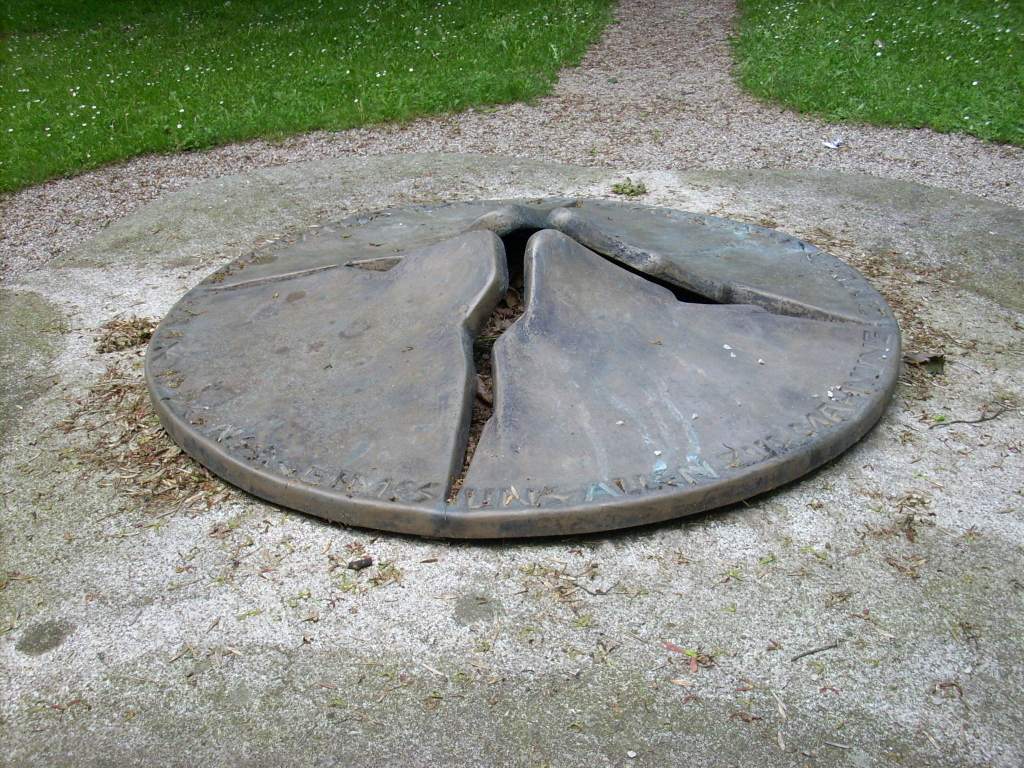 Source: Author.
Source: Author.
On the initiative of physicians at the hospital a
memorial created by the sculptor Josef Gollwitzer was placed next to the
Protestant chapel in 1990. The occasion was the 50th anniversary of the
first transport of patients to the T4 killing facility Grafeneck.
The bronze plate has the inscription 'In memory of the victims of
Euthanasia during the time of National Socialism and as a warning.'
Children's 'euthanasia' is not separately mentioned there, but a display
close to the memorial displays the inscription and the following
additional text: 'On 18 January 1940 the first patients were sent off for
extermination. 50 years later the dedication of the memorial occurred.
Denial, forgetting, and repression of these acts of violent do not result
in liberation. Only the deliberate look into this dark mirror enables us
to decide and act freely and prevents us from incurring guilt once again.
On the order of the National Socialist government in 1940-41, as far as is
known, 924 patients at Eglfing-Haar and 746 people who had previously
lived at other institutions were transported to a facility of death. At
least 332 children fell victim to a systematic killing by means of an
overdose of sedatives between November 1940 and May 1945. From 1943 to
1945 429 patients died in so-called 'hunger homes' as a result of
receiving a special diet without fat or protein. Detailed documentation
[is available] in the museum of psychiatry.' A report details the
commemorative events in 1990 (Bezirk Oberbayern 1992). In contrast to the
commemorative volume (Festschrift) 15 years earlier, the Festschrift on
occasion of the 90th anniversary now included, for the first time, a page
expressly dedicated to thematizing the 'euthanasia' murders
(Bezirkskrankenhaus Haar 1995, p. 27).
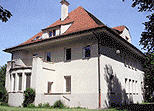 Source:
http://www.bezirk-oberbayern.de/showobject.phtml?La=1&object=tx|379.2695.1&sub=0
Source:
http://www.bezirk-oberbayern.de/showobject.phtml?La=1&object=tx|379.2695.1&sub=0
After earlier attempts to establish a museum in 1980
and 1984 did not materialize, in 2005, on occasion of the centenary of the
foundation of the clinic, a museum
of psychiatry opened on clinic property, based on the efforts of
clinic personnel in the nursing department. The museum documents the 100-year history of the
clinic and contains such things as a reconstructed living room, parts of
an isolation cell, and medical equipment. In one room it addresses the
NS-period, which includes references to children's 'euthanasia.'
By 2008, the museum had welcomed its 5,000th visitor, and it expects to
have an annual number of 2,000 visitors over the next few years, drawing
from students, patients, political groups, and members of civic and
charitable organizations. There is also an art installation in the
stairway of the building housing the museum, entitled 'Let me fell your
life.' There has also been a reading from a novel, 'Der Blechsoldat,' by
writer Marianne Ach.
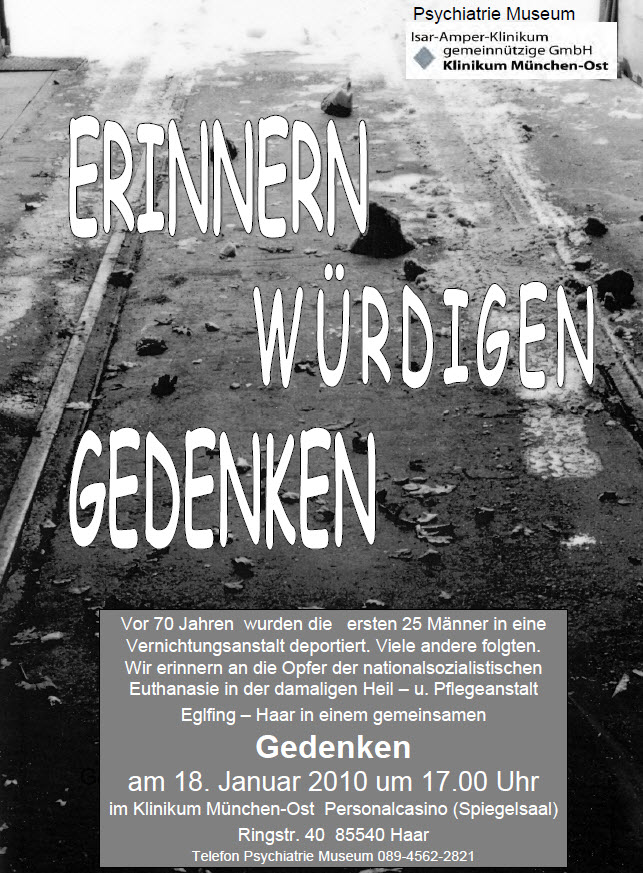
On January 18, 2010, on occasion of the first transport of 18 men from
Eglfing-Haar to the gas murder facility Grafeneck (the first 'official' T4
transport), commemorative events were held at both Eglfing-Haar and Stuttgart.
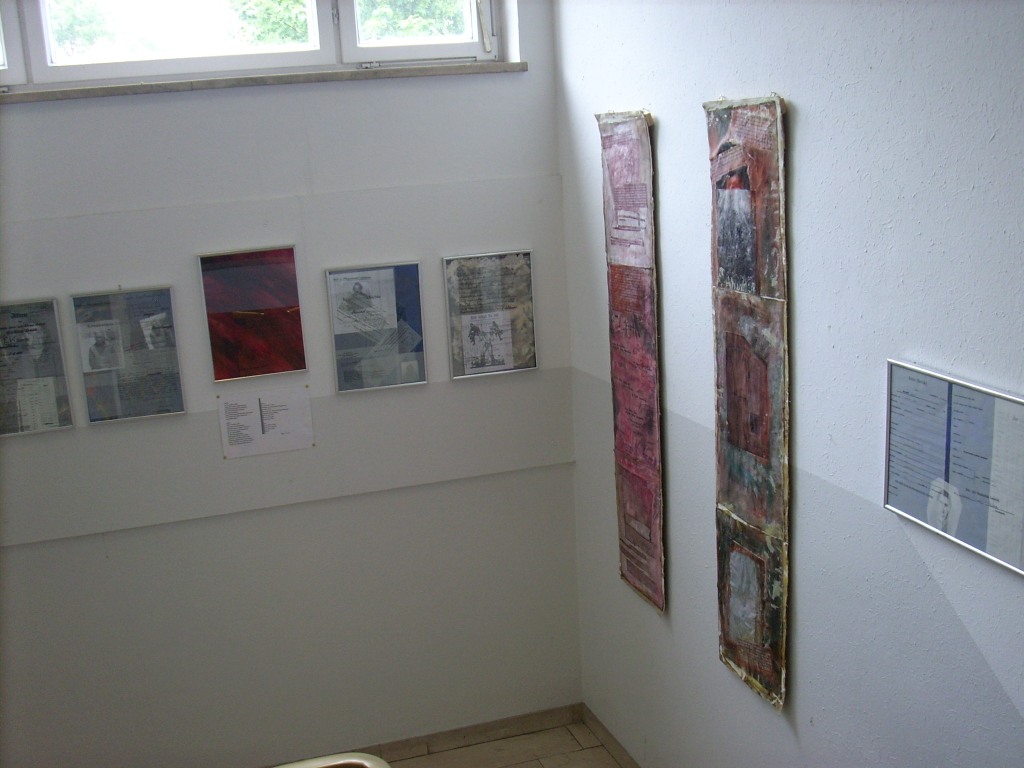 Source: Author.
Source: Author.
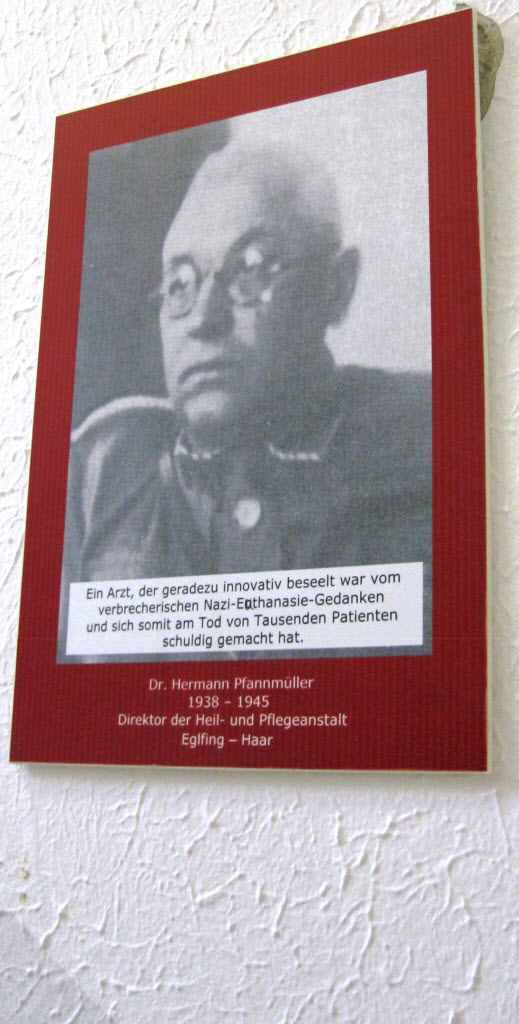 Source: Author.
Source: Author.
In the stairway of the clinic was an art installation and is now several
pictures, including one of the former director, Dr. Pfannmueller.
The clinic museum also has a web site, where in the clinic history section
'euthanasia' crimes are addressed, and the exhibit section addresses
children's euthanasia expressly.
Source: Psychiatriemuseum Klinikum Muenchen Ost
 Source: Psychiatriemuseum
Klinikum Muenchen Ost
Source: Psychiatriemuseum
Klinikum Muenchen Ost
A working group 'Psychiatry and Care during National Sozialism'
(Arbeitsgruppe 'Psychiatrie und Fuersorge im Nationalsozialismus' has
engaged in a series of events, including a public event focusing on the
child victims that occurred in March 2013 in Munich: http://www.kjp.med.uni-muenchen.de/download/symp_opfern_eine_stimme_flyer.pdf.
One of the presenters addressed a project that elicits, documents, and
analyzes witness testimony, such as that of the sisters of a child victim,
Wolfgang Sandlein (see here),
whose short biography has also been published (Eberle and Hohendorf 2014). A
public reading of the names of victims, including those of Eglfing-Haar
occurred on 18 January 2013 (see flyer),
and the new Munich Documentation Center for the History of National
Socialism includes an informative section online
on Dr. Pfannmueller.
In 2014, the exhibit 'In memory of the children' was display in the town
hall. It included a panel on Eglfing-Haar. Information here
and here.
One of the presenters was the physician Julia Koch, who is writing her
medical dissertation on the 'special children's ward' at the Institute for
History and Ethics of Medicine at the Technical University Munich (Institut
fuer Geschichte und Ethik der Medizin der TU Muenchen).
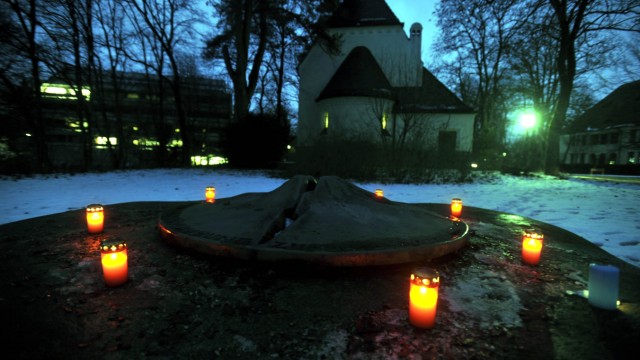
The above shows a picture of a recent commemoration (Source: http://polpix.sueddeutsche.com/bild/1.2304799.1421252239/640x360/gedenken-euthanasieopfer.jpg).
A relative of one of the child victims, whose name was Hans Dieter
Riess, published a web
page about the fate of the child. The child had a disability
(trisomy 21) and was murdered at Eglfing-Haar.
A niece of Helma (Wilhelmine) Haussner, another victim, published a brief
biography in 2014 (Busch 2014). The central T4 memorial site in Berlin
also provided information about this victim.
In 2018, a memorial book with the full names and vital dates of Munich
victims of 'euthanasia' was published. It includes the child victims of
the Kinderfachabteilung who resided in Munich. Julia Katzur's medical
dissertation of 2017 provides a detailed examination of the Special
Children's Ward.
Digital reproductions of records of the Grafeneck trial relate to a number
of children from Wurttemberg who died in the Eglfing-Haar facility between
1941 and 1945 (http://www.landesarchiv-bw.de/plink/?f=6-902779).
Literature
Alexander, Leo. 1945. 'Public Mental Health Practices in Germany:
Sterilization and Execution of Patients Suffering from Nervous or Mental
Disease.' Cios Item 24 Medical. Armed Forces Supreme Headquarters: Combined
Intelligence Objectives Sub-Committee.
Benzenhoefer, Udo. 2003. 'Genese und Struktur der
'NS-Kinder- und Jugendlicheneuthanasie.'' Monatsschrift
fuer Kinderheilkunde 151: 1012-19.
-------. 2020. Kindereuthanasie in der NS-Zeit
unter besonderer Beruecksichtigung von Reichsausschussverfahren und
Kinderfachabteilungen (Ulm: Klemm & Oelschlaeger, 2020)
Bezirk Oberbayern, ed. 1956. Das
Nervenkrankenhaus Haar bei Muenchen
des Bezirks Oberbayern, 1905-1955. Traunstein: Chiemgau-Druck.
-------. 1992. Die Zukunft ist die Verbannung der Gegenwart.
Munich: n.p.
Bezirkskrankenhaus Haar, ed. 1980. Festschrift
zum 75-jaehrigen Bestehen des Bezirkskrankenhauses Haar
bei Muenchen.
Haar: n.p.
-------. 1995. Festschrift zum 90-jaehrigen Bestehen des
Bezirkskrankenhauses Haar bei Muenchen. Haar: n.p.
Busch, Claudia. 2014. 'Meine Tante Helma (Wilhelmine) Haussner.' Pp.
170-72 in Die 'Euthanasie'-Opfer
zwischen Stigmatisierung und Anerkennung: Forschungs- und
Ausstellungsprojekte zu den Verbrechen an psychisch Kranken und die
Frage der Namensnennung der Muenchner 'Euthanasie'-Opfer, edited
by Gerrit Hohendorf, Stefan Raueiser, Michael von Cranach, and Sibylle von
Tiedemann. Munster: Kontur.
Eberle, Annette, and Gerrit Hohendorf. 2014. 'Wolfgang Sandlein: Opfer
der 'Kinderfachabteilung.'' Pp. 201-202 in in Die
'Euthanasie'-Opfer zwischen Stigmatisierung und Anerkennung: Forschungs-
und Ausstellungsprojekte zu den Verbrechen an psychisch Kranken und die
Frage der Namensnennung der Muenchner 'Euthanasie'-Opfer, edited
by Gerrit Hohendorf, Stefan Raueiser, Michael von Cranach, and Sibylle von
Tiedemann. Munster: Kontur.
Gedenkbuch fuer die Muenchner Opfer der nationalsozialistischen
'Euthanasie'-Morde, edited by the NS-Documentation Center Munich and
the District Upper Bavaria by Michael von Cranach, Annette Eberle, Gerrit
Hohendorf, and Sibylle von Tiedemann (Frankfurt: Wallstein, 2018).
Hohendorf, Gerrit. 2007-2008a. 'The Representation of Nazi 'Euthanasia' in
German Psychiatry 1945 to 1998: A Preliminary Survey.' Korot
19: 29-48.
-------. 2007-2008b.
'The Sewering Affair.' Korot 19:
83-104.
Kaelber, Lutz. 2012. 'Child Murder in Nazi Germany: The
Memory of Nazi Medical Crimes and Commemoration of 'Children's Euthanasia'
Victims at Two Facilities (Eichberg, Kalmenhof).' Societies
2 (2012): 157-194. Available at https://www.uvm.edu/~lkaelber/societies-02-00157.pdf
Katzur, Julia. 2017. 'Die 'Kinderfachabteilung' in der
Heil- und Pflegeanstalt Eglfing-Haar und die nationalsozialistische
'Kindereuthanasie' zwischen 1940-1945,' M.D. Dissertation, Medical
College, Technical University Munich.
Krischer, Markus. 2006. Kinderhaus:
Leben und Ermordung des Maedchens Edith Hecht. Munich: Deutsche
Verlags-Anstalt.
Michler, Rainer and Gabi Forcht. 1984. 'Morde an
geisteskranken Kindern und Jugendlichen in Haar.' Tuerspalt
10: 29-36. Available at http://www.kulturkritik.net/psychiatrie/haar/index.html.
Richarz, Bernhard. 1987. Heilen,
Pflegen, Toeten: Zur Alltagsgeschichte einer Heil- und Pflegeanstalt bis
zum Ende des Nationalsozialismus. Goettingen: Verlag fuer
Medizinische Psychologie.
Rueckert,
Klaus. 2009 (September). Personal communication.
Schmidt, Gerhard. 1965. Selektion
in der Heilanstalt, 1939-1945. Stuttgart: Evangelisches
Verlagswerk.
-------. 2005. 'Das
unerwuenschte Buch.' Pp. 3-10 in Aktuelle
Kernfragen in der Psychiatrie, edited by Felix Boecker and
Wolfgang Weig. Berlin: Springer-Verlag.
Steger, Florian. 2006. 'Neuropathological research at
the 'Deutsche Forschungsanstalt fuer Psychiatrie' (German Institute for
Psychiatric Research) in Munich (Kaiser-Wilhelm-Institute): Scientific
utilization of children's organs from the 'Kinderfachabteilungen'
(Children's Special Departments) at Bavarian State Hospitals.' Journal
of the History of the Neurosciences 15: 173-85.
Stockdreher, Petra. 1999. 'Heil- und Pflegeanstalt
Eglfing-Haar.' Pp. 327-62 in Psychiatrie
im Nationalsozialismus: Die Bayerischen Heil- und Pflegeanstalten
zwischen 1933 und 1945, edited by M. von Cranach and H.-L.
Siemen. Munich: R. Oldenbourg Verlag.
Tiedemann, Sibylle von. 2014. 'Dezentrale 'Euthanasie'
in der Heil- und Pflegeanstalt Eglfing-Haar: Eine Untersuchung der
Muenchner Todesfaelle, 1939-1945.' Pp. 34-51 in Die
'Euthanasie'-Opfer zwischen Stigmatisierung und Anerkennung: Forschungs-
und Ausstellungsprojekte zu den Verbrechen an psychisch Kranken und die
Frage der Namensnennung der Muenchner 'Euthanasie'-Opfer, edited
by Gerrit Hohendorf, Stefan Raueiser, Michael von Cranach, and Sibylle von
Tiedemann. Munster: Kontur.
Topp, Sascha. 2004. 'Der 'Reichsausschuss zur wissenschaftlichen Erfassung
erb- und anlagebedingter schwerer Leiden': Zur Organisation der Ermordung
minderjaehriger Kranker im Nationalsozialismus 1939-1945.' Pp. 17-54 in Kinder in der NS-Psychiatrie, edited by Thomas Beddies and
Kristina Huebener. Berlin-Brandenburg: Be.bra Wissenschaft.
-------. 2005. 'Der
'Reichsausschuss zur wissenschaftlichen Erfassung erb- und anlagebedingter
schwerer Leiden': Die Ermordung minderjaehriger Kranker im
Nationalsozialismus 1939-1945.' Master's Thesis in History, University of
Berlin.
Concerning 'euthanasia' trial(s)
for this location
Bauer, Fritz et al., eds. 1968-1981. Justiz
und NS-Verbrechen: Sammlung deutscher Strafurteile wegen
nationalsozialistischer Toetungsverbrechen, 1945-1966. Amsterdam:
University Press Amsterdam. Vol. 3, pp. 17ff; vol. 8, pp. 283ff.
Bryant, Michael S. 2005. Confronting the
'Good Death': Nazi Euthanasia on Trial, 1945-1953. Boulder:
University of Colorado Press. Pp. 192-98.
Freudiger, Kerstin. 2002. Die juristische
Aufarbeitung von NS-Verbrechen. Tuebingen: Mohr Siebeck. Pp.
272-78.
Last updated in August 2023
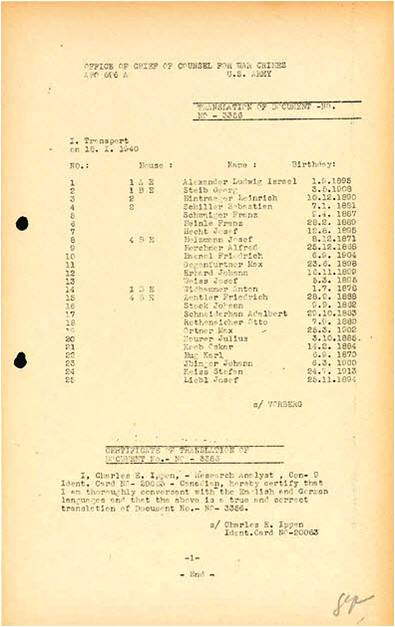

 Source:
Author.
Source:
Author. Source:
http://www.bezirk-oberbayern.de/showobject.phtml?La=1&object=tx|379.2695.1&sub=0
Source:
http://www.bezirk-oberbayern.de/showobject.phtml?La=1&object=tx|379.2695.1&sub=0
 Source: Author.
Source: Author.

 Source: Psychiatriemuseum
Klinikum Muenchen Ost
Source: Psychiatriemuseum
Klinikum Muenchen Ost